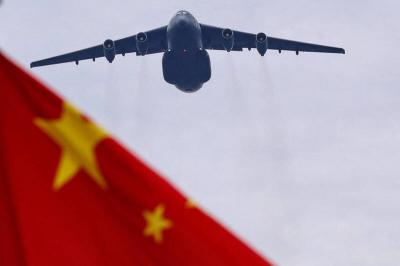A growing percentage of Taiwanese view the nation’s trade relationship with China as competitive rather than mutually beneficial, according to a poll published yesterday.
The survey conducted by the Chinese-language United Daily News found that 41 percent of Taiwanese see cross-strait economic and trade relations as competitive, the highest percentage since 2010, when the newspaper started the annual poll on the development of Taiwan-China ties.
Only 17 percent of Taiwanese think cross-strait economic relations are more complementary than competitive, while 32 percent think that the links are both reciprocal and competitive, the poll showed.
Last year, the survey found that 35 percent of people in Taiwan viewed the ties as more complementary than competitive.
Overall, cross-strait economic relations were given a score of 6.4 on a scale of 1 to 10, with 1 to 4 meaning friendly or complementary, 5 to 6 indicating an improving relationship and 7 to 10 signifying tense or competitive relations.
The scale was used to gauge five areas of cross-strait ties — politics, military, foreign relations, trade and society.
In the military section, 36 percent of Taiwanese said this year that cross-strait relations were tense, compared with 19 percent last year, while 37 percent saw the situation as improving.
Overall, cross-strait military relations scored 6.5 points.
The poll also uncovered that Taiwanese think there is increasing competition in cross-strait diplomacy, with 49 percent rating it as highly competitive, 30 percent as improving and just 11 percent as easing.
With an overall score of 6.9, cross-strait diplomacy was found to be the most competitive aspect of relations across the strait.
Despite the perception of growing economic, military and diplomatic competition across the strait, Taiwanese view relations between the two sides generally as peaceful, the poll showed.
Most Taiwanese think there is not much chance of a war with China and want to “maintain the ‘status quo’” in terms of relations with China, the poll found.
On a scale of 1 to 10, the average score on the possibility of a war between Taiwan and China was 3.2, with 10 indicating the highest possibility.
On the issue of Taiwan’s status, 47 percent of Taiwanese want to maintain the “status quo,” 19 percent would like to see the nation claim immediate independence, while 15 percent would prefer to keep the “status quo” now and move toward independence later, the poll showed.
About 4 percent favor an immediate “unification” with China, 8 percent would prefer a gradual process and 7 percent are undecided or have no opinion, the survey found.
Meanwhile, 31 percent of Taiwanese think cross-strait social links are warming because of private exchanges, 44 percent see such ties as improving and 19 percent think that those relations are still cold, the poll found. Overall, social relationships across the strait were given 5.3 points, the highest score among the five areas in the survey.
This year’s survey, conducted from Sept. 7 to Sept. 10 by telephone, collected 1,010 valid samples from throughout Taiwan. It had a confidence level of 95 percent and a margin of error of 3.1 percentage points, the paper said.

Beijing could eventually see a full amphibious invasion of Taiwan as the only "prudent" way to bring about unification, the US Department of Defense said in a newly released annual report to Congress. The Pentagon's "Annual Report to Congress: Military and Security Developments Involving the People's Republic of China 2025," was in many ways similar to last year’s report but reorganized the analysis of the options China has to take over Taiwan. Generally, according to the report, Chinese leaders view the People's Liberation Army's (PLA) capabilities for a Taiwan campaign as improving, but they remain uncertain about its readiness to successfully seize

Taiwan is getting a day off on Christmas for the first time in 25 years. The change comes after opposition parties passed a law earlier this year to add or restore five public holidays, including Constitution Day, which falls on today, Dec. 25. The day marks the 1947 adoption of the constitution of the Republic of China, as the government in Taipei is formally known. Back then the Chinese Nationalist Party (KMT) governed China from Nanjing. When the KMT, now an opposition party in Taiwan, passed the legislation on holidays, it said that they would help “commemorate the history of national development.” That

Taiwan has overtaken South Korea this year in per capita income for the first time in 23 years, IMF data showed. Per capita income is a nation’s GDP divided by the total population, used to compare average wealth levels across countries. Taiwan also beat Japan this year on per capita income, after surpassing it for the first time last year, US magazine Newsweek reported yesterday. Across Asia, Taiwan ranked fourth for per capita income at US$37,827 this year due to sustained economic growth, the report said. In the top three spots were Singapore, Macau and Hong Kong, it said. South

Snow fell on Yushan (Jade Mountain, 玉山) yesterday morning as a continental cold air mass sent temperatures below freezing on Taiwan’s tallest peak, the Central Weather Administration (CWA) said. Snowflakes were seen on Yushan’s north peak from 6:28am to 6:38am, but they did not fully cover the ground and no accumulation was recorded, the CWA said. As of 7:42am, the lowest temperature recorded across Taiwan was minus-5.5°C at Yushan’s Fengkou observatory and minus-4.7°C at the Yushan observatory, CWA data showed. On Hehuanshan (合歡山) in Nantou County, a low of 1.3°C was recorded at 6:39pm, when ice pellets fell at Songsyue Lodge (松雪樓), a